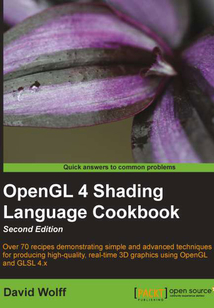舉報 

會員
OpenGL 4 Shading Language Cookbook(Second Edition)
最新章節:
Index
OpenGLShadingLanguage4Cookbookisahands-onguidethatgetsstraighttothepoint–actuallycreatinggraphics,insteadofjusttheoreticallearning.Eachrecipeisspecificallytailoredtosatisfyyourappetiteforproducingreal-time3-DgraphicsusingthelatestGLSLspecification.ThisbookisforOpenGLprogrammerslookingtousethemodernfeaturesofGLSL4tocreatereal-time,three-dimensionalgraphics.FamiliaritywithOpenGLprogramming,alongwiththetypical3Dcoordinatesystems,projections,andtransformationsisassumed.ItcanalsobeusefulforexperiencedGLSLprogrammerswhoarelookingtoimplementthetechniquesthatarepresentedhere.
目錄(107章)
倒序
- coverpage
- OpenGL 4 Shading Language Cookbook Second Edition
- Credits
- About the Author
- About the Reviewers
- www.PacktPub.com
- Support files eBooks discount offers and more
- Preface
- What this book covers
- What you need for this book
- Who this book is for
- Conventions
- Reader feedback
- Customer support
- Chapter 1. Getting Started with GLSL
- Introduction
- Using a function loader to access the latest OpenGL functionality
- Using GLM for mathematics
- Determining the GLSL and OpenGL version
- Compiling a shader
- Linking a shader program
- Sending data to a shader using vertex attributes and vertex buffer objects
- Getting a list of active vertex input attributes and locations
- Sending data to a shader using uniform variables
- Getting a list of active uniform variables
- Using uniform blocks and uniform buffer objects
- Getting debug messages
- Building a C++ shader program class
- Chapter 2. The Basics of GLSL Shaders
- Introduction
- Implementing diffuse per-vertex shading with a single point light source
- Implementing per-vertex ambient diffuse and specular (ADS) shading
- Using functions in shaders
- Implementing two-sided shading
- Implementing flat shading
- Using subroutines to select shader functionality
- Discarding fragments to create a perforated look
- Chapter 3. Lighting Shading and Optimization
- Introduction
- Shading with multiple positional lights
- Shading with a directional light source
- Using per-fragment shading for improved realism
- Using the halfway vector for improved performance
- Simulating a spotlight
- Creating a cartoon shading effect
- Simulating fog
- Configuring the depth test
- Chapter 4. Using Textures
- Introduction
- Applying a 2D texture
- Applying multiple textures
- Using alpha maps to discard pixels
- Using normal maps
- Simulating reflection with cube maps
- Simulating refraction with cube maps
- Applying a projected texture
- Rendering to a texture
- Using sampler objects
- Chapter 5. Image Processing and Screen Space Techniques
- Introduction
- Applying an edge detection filter
- Applying a Gaussian blur filter
- Implementing HDR lighting with tone mapping
- Creating a bloom effect
- Using gamma correction to improve image quality
- Using multisample anti-aliasing
- Using deferred shading
- Implementing order-independent transparency
- Chapter 6. Using Geometry and Tessellation Shaders
- Introduction
- Point sprites with the geometry shader
- Drawing a wireframe on top of a shaded mesh
- Drawing silhouette lines using the geometry shader
- Tessellating a curve
- Tessellating a 2D quad
- Tessellating a 3D surface
- Tessellating based on depth
- Chapter 7. Shadows
- Introduction
- Rendering shadows with shadow maps
- Anti-aliasing shadow edges with PCF
- Creating soft shadow edges with random sampling
- Creating shadows using shadow volumes and the geometry shader
- Chapter 8. Using Noise in Shaders
- Introduction
- Creating a noise texture using GLM
- Creating a seamless noise texture
- Creating a cloud-like effect
- Creating a wood-grain effect
- Creating a disintegration effect
- Creating a paint-spatter effect
- Creating a night-vision effect
- Chapter 9. Particle Systems and Animation
- Introduction
- Animating a surface with vertex displacement
- Creating a particle fountain
- Creating a particle system using transform feedback
- Creating a particle system using instanced particles
- Simulating fire with particles
- Simulating smoke with particles
- Chapter 10. Using Compute Shaders
- Introduction
- Implementing a particle simulation with the compute shader
- Using the compute shader for cloth simulation
- Implementing an edge detection filter with the compute shader
- Creating a fractal texture using the compute shader
- Index 更新時間:2021-07-21 17:51:21
推薦閱讀
- 精通MATLAB神經網絡
- JavaScript實例自學手冊
- PostgreSQL 11 Server Side Programming Quick Start Guide
- 商戰數據挖掘:你需要了解的數據科學與分析思維
- 數據中心建設與管理指南
- Windows XP中文版應用基礎
- VMware Performance and Capacity Management(Second Edition)
- Hadoop Real-World Solutions Cookbook(Second Edition)
- 內模控制及其應用
- Silverlight 2完美征程
- 傳感器與自動檢測
- 貫通開源Web圖形與報表技術全集
- 大數據素質讀本
- Hadoop Beginner's Guide
- 中文版Photoshop情境實訓教程
- MySQL Management and Administration with Navicat
- Web滲透技術及實戰案例解析
- Arduino創意機器人入門:基于Mind+
- ASP.NET 4.0 MVC敏捷開發給力起飛
- AVR單片機菜鳥進階
- Moodle 2.5 Multimedia
- 數據準備和特征工程:數據工程師必知必會技能
- 后期合成
- Prezi Essentials
- 電子商務網站規劃
- System Center 2016 Virtual Machine Manager Cookbook(Third Edition)
- Embedded Linux Development Using Yocto Project Cookbook(Second Edition)
- Puppet for Containerization
- Machine Learning with scikit:learn Quick Start Guide
- 決眥入歸鳥:Visual C++開發修行實錄

